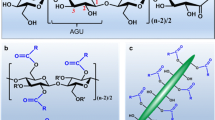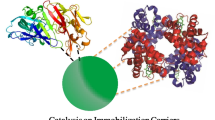Abstract
Objective
To improve the operational stability and reusability of an epoxide hydrolase (EH) for the biosynthesis of optically active epoxides.
Results
A covalently immobilization strategy was employed to improve the stability of Agrobacterium radiobacter EH by using ethylenediamine (EDA)-functionalised epoxy resin LX-1000EP as carrier. Under the optimal conditions, the activity recovery of immobilized enzyme was 72 % and the specific activity was 634 U/g. Immobilized EH exhibited significantly enhanced thermal stability with a half-life of more than 6.8-fold at 50 °C than that of the free enzyme. A gram-scale kinetic resolution of (R,S)-epichlorohydrin using immobilized preparation as biocatalyst was performed and (R)-epichlorohydrin was obtained with 35 % yield and 99 % enantiomeric excess. The immobilized EH showed good operational stability and even after six reactions, it retained >85 % of the initial activity.
Conclusion
The operational stability and recyclability of immobilized EH on an EDA-functionalized epoxy supports demonstrated its potential for producing (R)-epichlorohydrin.






Similar content being viewed by others
References
Aragon CC, Mateo C, Ruiz-Matute AI, Corzo N, Fernandez-Lorente G, Sevillano L, Díaz M, Monti R, Santamaría RI, Guisan JM (2013) Production of xylo-oligosaccharides by immobilized-stabilized derivatives of endo-xylanase from Streptomyces halstedii. Proc Biochem 48:478–483
Barbosa O, Torres R, Ortiz C, Berenguer-Murcia A, Rodrigues RC, Fernandez-Lafuente R (2013) Heterofunctional supports in enzyme immobilization: from traditional immobilization protocols to opportunities in tuning enzyme properties. Biomacromolecules 14:2433–2462
Choi WJ (2009) Biotechnological production of enantiopure epoxides by enzymatic kinetic resolution. Appl Microbiol Biotechnol 84:239–247
DiCosimo R, McAuliffe J, Poulose AJ, Bohlmann G (2013) Industrial use of immobilized enzymes. Chem Soc Rev 42:6437–6474
Jin HX, Hu ZC, Zheng YG (2012) Enantioselective hydrolysis of epichlorohydrin using whole Aspergillus niger ZJB-09173 cells in organic solvents. J Biosci 37:695–702
Jin HX, Liu ZQ, Hu ZC, Zheng YG (2013) Biosynthesis of (R)-epichlorohydrin at high substrate concentration by kinetic resolution of racemic epichlorohydrin with a recombinant epoxide hydrolase. Eng Life Sci 13:385–392
Karboune S, Neufeld R, Kermasha S (2005) Immobilization and biocatalysis of chlorophyllase in selected organic solvent systems. J Biotechnol 120:273–283
Liu ZQ, Zhang LP, Cheng F, Ruan LT, Hu ZC, Zheng YG, Shen YC (2011) Characterization of a newly synthesized epoxide hydrolase and its application in racemic resolution of (R,S)-epichlorohydrin. Catal Commun 16:133–139
Mateo C, Archelas A, Fernandez-Lafuente R, Guisan JM, Furstoss R (2003) Enzymatic transformations. Immobilized A. niger epoxide hydrolase as a novel biocatalytic tool for repeated-batch hydrolytic kinetic resolution of epoxides. Org Biomol Chem 1:2739–2743
Mateo C, Grazu V, Pessela BCC, Montes T, Palomo JM, Torres R, Lopez-Gallego F, Fernandez-Lafuente R, Guisan JM (2007) Advances in the design of new epoxy supports for enzyme immobilization-stabilization. Biochem Soc Trans 35:1593–1601
Mendes AA, de Castro HF, Rodrigues DD, Adriano WS, Tardioli PW, Mammarella EJ, Giordano RD, Giordano RDC (2011) Multipoint covalent immobilization of lipase on chitosan hybrid hydrogels: influence of the polyelectrolyte complex type and chemical modification on the catalytic properties of the biocatalysts. J Ind Microbiol Biotechnol 38:1055–1066
Mihailović M, Stojanović M, Banjanac K, Carević M, Prlainović N, Milosavić N, Bezbradica D (2014) Immobilization of lipase on epoxy-activated Purolite® A109 and its post-immobilization stabilization. Proc Biochem 49:637–646
Woo JH, Lee EY (2014) Enantioselective hydrolysis of racemic styrene oxide and its substituted derivatives using newly-isolated Sphingopyxis sp. exhibiting a novel epoxide hydrolase activity. Biotechnol Lett 36:357–362
Woo JH, Hwang YO, Kang JH, Lee HS, Kim SJ, Kang SG (2010) Enantioselective hydrolysis of racemic epichlorohydrin using an epoxide hydrolase from Novosphingobium aromaticivorans. J Biosci Bioeng 110:295–297
Xue F, Liu ZQ, Zou SP, Wan NW, Zhu WY, Zhu Q, Zheng YG (2014) A novel enantioselective epoxide hydrolase from Agromyces mediolanus ZJB120203: cloning, characterization and application. Proc Biochem 49:409–417
Yildirim D, Alagöz D, Alptekin Ö, Tükel SS (2010) Preparative-scale kinetic resolution of racemic styrene oxide by immobilized epoxide hydrolase. Enzy Microb Technol 150:378–379
Zheng GW, Xu JH (2011) New opportunities for biocatalysis: driving the synthesis of chiral chemicals. Curr Opin Biotechnol 22:784–792
Zou SP, Yan HW, Hu ZC (2013) Enzymatic resolution of epichlorohydrin catalyzed by whole cells in an organic solvent/buffer biphasic system. Chin J Catal 34:1339–1347
Acknowledgments
This work was financial supported by National Natural Science Foundation of China (No. 21406205).
Supporting information
Supplementary Fig. 1—Effect of immobilization temperature (a), pH (b), enzyme concentration (c), and immobilization time (d) on the activity of the immobilized enzyme.
Supplementary Fig. 2—1H-NMR spectra of the product [(R)-ECH].
Author information
Authors and Affiliations
Corresponding author
Electronic supplementary material
Below is the link to the electronic supplementary material.
Rights and permissions
About this article
Cite this article
Zou, SP., Wang, ZC., Qin, C. et al. Covalent immobilization of Agrobacterium radiobacter epoxide hydrolase on ethylenediamine functionalised epoxy supports for biocatalytical synthesis of (R)-epichlorohydrin. Biotechnol Lett 38, 1579–1585 (2016). https://doi.org/10.1007/s10529-016-2135-y
Received:
Accepted:
Published:
Issue Date:
DOI: https://doi.org/10.1007/s10529-016-2135-y




